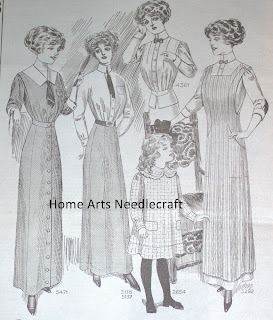January, 1912
page 14
Ladies’ Sailor Dress
The youthfulness of the popular sailor-dress makes it ever a favorite. No type of gowning is so generally becoming to the miss or young woman, and the classy number shown in design No. 5471, will find many advocates.
The garment has the regulation middy-blouse waist, with large sailor-collar. Plaits over each shoulder are stitched to about bust-depth, where they are released, providing the necessary fullness. The back is perfectly plain. The sleeves are three-quarter length models, with turnback cuffs.
The chemisette is detachable, so dress may be worn with or without the yoke and collar.
The skirt is in five gores, with panel back. The costume closes the entire length of the front.
This dress may be made of serge, with silk collar and cuffs or, if a wash-dress is preferred, linen, pique, madras or chambray may be used.
The pattern, No. 5471, is cut in sizes from 32 to 42 inches bust measure. To make the dress in the medium size will require 7 5/8 yards of 27-inch, 5 ½ yards of 36-inch, or 4 5/8 yards of 44-inch material. Price of pattern, 10 cents.
Ladies’ Shirtwaist Costume
An attractive model for a shirtwaist costume is here shown, illustration No. 5118 and No. 5132.
The waist of this costume is cut on kimono lines, having body and upper part of sleeve in one. The absence of fullness makes it especially desirable for a tailored model. The neckband admits of any-style collar being worn, and the cuffs are the regulation, mannish style. A pocket on the left side front, gives a jaunty addition. The waist closes visibly down the front, through a center box plait.
The skirt is cut in nine gores, and can be made in round or ankle length. The front gore gives the panel-effect, and there is an inverted box plait at the back.
For business wear, a costume of this nature is serviceable and practical. The waist and skirt can be made of the same material, or of separate goods.
For instance, the waist can be developed in madras, flannelette, or silk, to be worn with the skirt fashioned of Henrietta, panama, or serge. An all-serge costume would be nice, or one of linen, if preferred.
The waist-pattern, No. 5118, is cut in sizes from 32 to 42 inches bust measure. To make the waist in the medium size will require 2 1/8 yards of 36-, or 1 ¾ yards of 44-inch material. Price of pattern, 10 cents.
The skirt-pattern, No 5132, is cut in sizes from 22 to 36 inches waist measure. To make the skirt in the medium size will require 4 ¾ yards of 36-, or 3 ¾ yards of 44-inch material. Price of pattern, 10 cents.
Shirtwaist Dressing-Sacque
Something new in dressing-sacque is the shirtwaist model, which is not so negligee as the usual type, and is chic and stylish-looking.
As an illustration of this new idea in house-waists, No. 4361 presents an attractive suggestion.
This garment is made along the regular shirtwaist lines. Two plaits on each side of the front regulate the fullness. The back is perfectly plain.
The sleeves are fuller than the regular shirtwaist-sleeve, and are finished with a neat puritan cuff. At the bottom of the waist is attached a straight peplum, joined to the belt.
The pattern provides for two styles of sacque, so either can be obtained, the sacque with tucked front and plain sleeve as illustrated, or one with plain front and bishop sleeve. Both have standing collar, but the bishop sleeve has a band cuff.
The pattern, No, 4361, is cut in sizes from 32 to 44 inches bust measure. To make the sacque in the medium size will require 3 3/8 yards of 27-inch, or 2 ½ yards of 36-inch material. Price of pattern, 10 cents.
Children’s Apron
This pretty little apron, illustration No. 2654, can also be used as a dress for the little girl. Worn over the frock, it affords excellent protection, as it fastens up close to the neck at front, and covers the undergarment entirely at the back.
The front of the apron is plain, and hangs loose from the shoulders. There are two large pockets which relived the plainness.
At the back the garment is gathered to a square yoke. The apron buttons from the neck to the waistline, but the backs lap the rest of the length, in closed-effect.
The full bishop sleeves are finished with a neat band cuff, edged with narrow lace, or a ruffle of the material. The divided rolling collar is similarly treated.
A sash and bow tie at the back complete the little garment.
Gingham, madras, or percale may be used.
The pattern, NO, 2654, is cut in sizes for from 2 to 12 years. To make the apron in the medium size will require 3 ¼ yards of 27-inch material, or 2 5/8 yards of goods 36 inches wide. Price of pattern, 10 cents.
Ladies’ Work-Apron
Something new and attractive in work-aprons for kitchen or studio is shown in design No. 5292.
The apron has the new princesse panel at front. There are two large pockets which are stitched where front and sides are joined. The closing at the back is accomplished by straps which cross over the waist, and fasten on the shoulders.
There is a certain swagger cut about this apron, which distinguishes it from ordinary garments of the same nature.
Gingham is the best material to use, and the yoke and pockets may be trimmed with cotton braid of a corresponding color to give a touch of embellishment.
The pattern, No. 5292, is cut in sizes for 32, 36, 40 and 44 inches bust measure. To make the garment in the medium size will require 4 ¾ yards of 27-inch, or 3 ¾ yards of 36-inch material. Price of pattern, 10 cents.






No comments:
Post a Comment